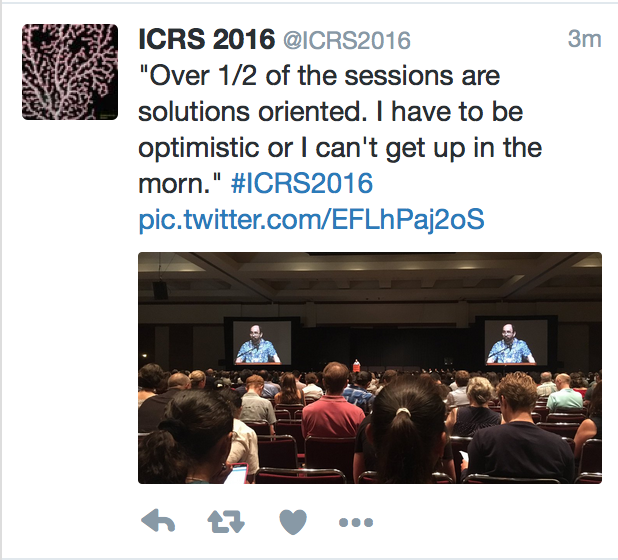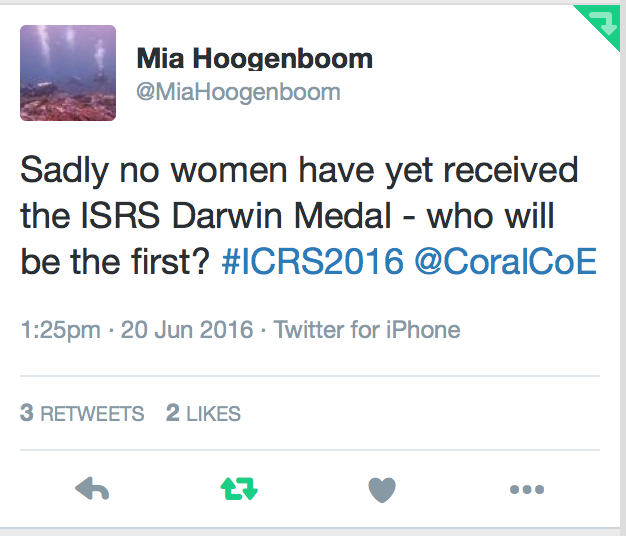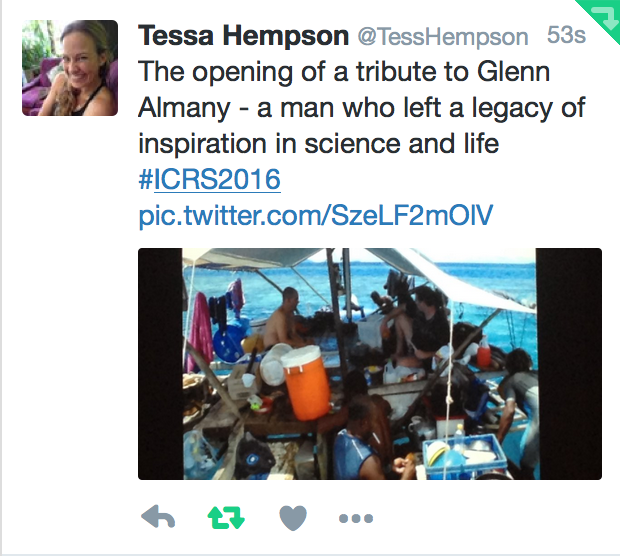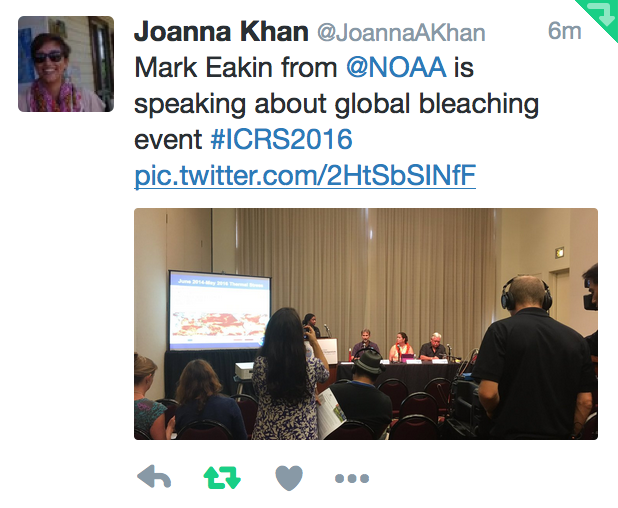International Coral Reef Symposium Day 1 - My highlights
20 June 2016, Honolulu Hawaii
See also my blog on ICRS: Key insights that will be updated daily.
Plenary
The theme of this conference is science to policy and the plenary speakers wasted no time in emphasising the importance of communicating science to broader audiences to the 2500 people in attendance.
As evidence of the importance of reef science to policy, there are three presidents from sovereign nations in attendance at the conference.
Ruth Gates, president of the International Society for Reef Studies, wants us to tell the society how to best achieve impact to conserve coral reefs. To this ends, there will be special sessions on Friday to synthesise the conference’s science for policy and public communication.
Bob Richmond, the conference convener, emphasised the interdisciplinary nature of the conference, with scientists, educators and policy-makers in attendance. He said we need to move from academic outputs, like papers, towards policy impact.
A few stats >1500 oral presentations, >700 posters and 45 sessions. Ruth Gates acknowledged the ‘mammoth’ effort Bob Richmond and the conference organizing team had made to put this together. It’s great to be here and I am certainly grateful for their efforts to bring this event together.

Science to policy is the central theme of this conference. Source: http://twitter.com
Darwin Award Medal - Jack Randall
Jack Randall received the Darwin award medal, the International Society for Reef Studies highest honour. Dr Randall gracefully accepted the award and told a series of amusing and touching stories from his career.
Dr Randall described purchasing his first aqua-lung. He didn’t know where to get an air tank from, so he went to the welding shop and got a bottle of oxygen (audience gasps). Someone told him later that if he had dived much deeper than he did, he wouldn’t be hear today (oxygen is toxic deeper than about 6 metres).
Dr Randall is an eminent coral reef fish taxonomist whose career has spanned >70 years. During his career he described >700 new marine species and pioneered scientific diving. You can read more about his productive and influential career on Christie Wilcox’s artile for the Hakai Magazine.

Several people noted on Twitter that there have been 7 Darwin awards, but none yet to women. Let's hope we see more nominations for women for the next award. Source: http://twitter.com
Keynote from President Remengesau of Palau
President Remengesau said that in Palau the ocean is life and it brings us together. He wants us to realize that Palau is not a ‘small island state’ but a ‘large ocean state’. Like many Palauans the ocean is integral to his cultural identity and livelihood. He considers himself a fisherman who has taken time off for public service. Palau has a >1000 year long history of ocean stewardship.
Palau has established shark sanctuaries and has led the effort to establish protected areas across the Pacific. Economic incentives have been integral to ocean protection. For instance, they have implemented a green tax as part of the depature tax at airports. This helps support ocean conservation efforts.
Another example comes from reef sharks, whicha are estimated to be worth $1.9 Million over the course of their lifespan - 100s times more than their value for shark-fin soup.
Traditional ecological knowledge is the backbone of Palau’s management and governance. Palau’s local scientists (sorry missed the name) emphasised the need to return to traditional governance systems, like species and temporal closures. Subsistence fishing is therefore a key part of their protected area efforts, as it ensures food-security of local people into the future.
President Remengesau believes large marine protected areas are essential for both marine biodiversity conservation and supporting local livelihoods. Palau has declared one of the world’s largest marine protected area systems. This decision is science-based.
Sustainable development of tourism and fisheries while protecting reef biodiversity that is threatened by climate change is a key dilemma faced by many island nations. Palau is pushing back by reducing local stresses to reefs. They are also strongly engaged with global policy push for greenhouse sustainability.
He concluded by saying we are at a cross-road for making decisions about the future health of reefs. It is essential to build trusting and long-term relationships to bridging the science to policy gap. We need 2016 to be the year of implementation for projects that can conserve reefs and dependent livelihoods.

Many people were touched and inspired by a memorial session on reef fish ecology held in honour of Dr Glenn Almany. I only met Glenn a few times, but the science he did has influenced my work and he has left a lasting legacy for coral reef science and conservation. Source: http://twitter.com
Corals of the world
Dr Charlie Veron announced the Corals of the World, an online platform for coral geography and identification. It’s exciting to see coral reef ecology going online and reaching a greater audience.
Ecosystem-based management
I was in the EBM session this morning. The session was opened by Fogarty, who spoke about the importance of considering trade-offs to achieve ecosystem based management.
Next up was Brainard, speaking on behalf of Pomeroy about the Coral Triangle Initiative’s Ecosystem Approach to Fishery Management. Brainard defined the Ecological approach to fishery management as trying to achieve a balance between ecological and societal wellbeing through effective governance.
Again Brainard emphasised the importance of balancing multiple objectives. Many countries, e.g. PNG, Indonesia, have a history of ecosystem approaches going back to the 90s. We have learned much from these early examples, such as the work on marine protected areas in the Philippines.
A challenge is that while the principles of ecosystem approach are in national policies, data shortages and barriers to implementation are major challenges.
Lopez-Rivera from NOAA fisheries talked about the challenges of implementing science-based management. An attempt to reform management in Puerto-Rico failed because stakeholders were not willing to compromise on important trade-offs between fishing access and management and they also felt there was not enough evidence to support management changes.
Nash @NasherK reviewed indicators of fishing pressure and found most didn’t quantify actual gradients in fishing pressure!
Nash worked in the Seychelles to develop indicators of fishing pressure. Importantly, high size diversity of herbivorous fish was key to support coral reef resilience. This suggests size diversity is a useful indicator of both fishing pressure and ecological responses to disturbances.
Altman, from Boston University, talked about how conventional approaches to management focus on protecting the state of ecosystems, e.g. number of species, biomass hotspots and so on. Whereas ecosystem based management often focusses on functions of biodiversity, like services to humans and resilience of ecosystems to disturbance.
Tropicalisation of temperate reefs
It has been an interesting year for temperature reefs. Extremely warm ocean temperatures this year, which are driving a global bleaching event on coral reefs, has also seen large migrations of tropical species to temperature waters.

This years global bleaching event was on everyone's mind. Source: http://twitter.com
Australia’s south-east reefs are undergoing Tropicalisation. Booth has been doing surveys of tropical fish for many years now to find out which species are moving and to determine the mechanisms driving their movement and establishment success.
This summer has been particularly warm and has seen a large increase in the number of tropical fish arriving. Arrivals include surgeon fish - important herbivores on reefs that can change ecosystems through their herbivory. However, most don’t survive the winter, because it is too cold.
Booth joked that by the next conference, Sydney may house coral reefs. It has happened at a similar latitude in the northern hemisphere!
Sommer is testing the hypothesis that environmental filtering is stronger is areas of high abiotic stress. By looking at the traits of high latitude coral species, they found that species with more similar traits were more likely to survive at higher latitudes. So corals will probably only expand to areas that are similar to their core ranges.
Sommer also found that critical temperatures and temperature variability were more important for controlling coral species range edges than mean temperature - this is an important lesson for predictive modelling.
On Australia’s west coast, heat wave events are also seeing unprecedented recruitment of tropical fish in temperate waters. Following these changes will be important for future management of species like this grouper, which are important to fisheries.
Marine protected areas
Bob Pressey spoke about ineffective targets in conservation planning. Often reserves are ‘residual’ in that they are placed in areas that avoid pressures, like fishing, so don’t actually achieve anything for conservation.
We also need to be careful of coverage targets. Conservation objectives for area alone have become institutionalized, but the don’t reflect the quality of protection very well.
Finally, Pressey talked about the importance of assessing the counterfactual - what would have happened if we didn’t take a management action. For residual reserves what happened will be very similar to the counterfactual, so we discover that our action didn’t really have any impact for improving conservation.
Gabby Ahmadia provided a concrete example of designing a reserve monitoring program to quantify the counterfactual. She used impact evaluation methodology to identify paired ‘control-impact’ sites. They allow comparison of how biodiversity is faring inside protected areas to outside, while controlling for other differences, such as level of exposure to wind and access to markets.
Ahmadia showed that using this thorough evaluation methodology has a large effect on how you classify the success of MPA indicators like fish biomass.
Semmens presented analysis of citizen science data from the REEF surveys for Bonaire’s marine park. Bonaire’s park has a few small no-take protected areas, but largely allows subsistence fishing. There are many issues with citizen science data, however, Semmens points out that data collected by recreational divers on how many fish they see is ideal to evaluate the tourism experience.
Ceccarelli analysed effects of protection in the Great Barrier Reef marine park. The park mostly protects coral trout - the main fishery species. There is much functional redundancy across multiple species in the system, so overall fish community composition is similar inside and outside reserves.
That’s all from me for day 1. If you have anything to add, feel free to email me.